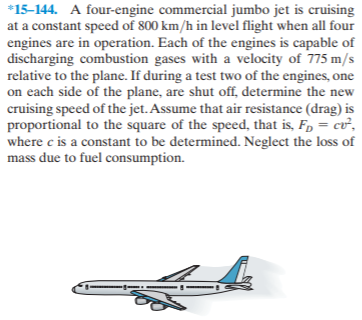*15-144. A four-engine commercial jumbo jet is cruising at a constant speed of 800 km/h in level flight when all four engines are in operation. Each of the engines is capable of discharging combustion gases with a velocity of 775 m/s relative to the plane. If during a test two of the engines, one on each side of the plane, are shut off, determine the new cruising speed of the jet. Assume that air resistance (drag) is proportional to the square of the speed, that is, F, = cv, where c is a constant to be determined. Neglect the loss of mass due to fuel consumption.
*15-144. A four-engine commercial jumbo jet is cruising at a constant speed of 800 km/h in level flight when all four engines are in operation. Each of the engines is capable of discharging combustion gases with a velocity of 775 m/s relative to the plane. If during a test two of the engines, one on each side of the plane, are shut off, determine the new cruising speed of the jet. Assume that air resistance (drag) is proportional to the square of the speed, that is, F, = cv, where c is a constant to be determined. Neglect the loss of mass due to fuel consumption.
Related questions
Question

Transcribed Image Text:*15-144. A four-engine commercial jumbo jet is cruising
at a constant speed of 800 km/h in level flight when all four
engines are in operation. Each of the engines is capable of
discharging combustion gases with a velocity of 775 m/s
relative to the plane. If during a test two of the engines, one
on each side of the plane, are shut off, determine the new
cruising speed of the jet. Assume that air resistance (drag) is
proportional to the square of the speed, that is, F, = cv,
where c is a constant to be determined. Neglect the loss of
mass due to fuel consumption.
Expert Solution
This question has been solved!
Explore an expertly crafted, step-by-step solution for a thorough understanding of key concepts.
This is a popular solution!
Trending now
This is a popular solution!
Step by step
Solved in 5 steps with 11 images
